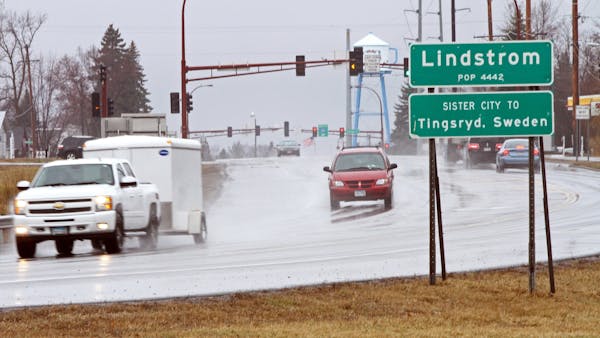Forget Lindstrom. The town of Lindström is getting its umlauts back.
Gov. Mark Dayton issued an executive order Wednesday requiring the Minnesota Department of Transportation to reinstate umlauts on roadway signage when appropriate.
"Underbart! [wonderful!]" said Sally Barott, an area resident and guide for Swedish tourists, using the Swedish she learned in a local high school. "I'm happily surprised that the governor stepped in."
The governor issued the order days after a Star Tribune report about city officials in Lindström upset that new signage did not include the two dots atop the "o" in the town's name. The story even made news in Sweden.
"Nonsensical rules like this are exactly why people get frustrated with government," Dayton said. "Even if I have to drive to Lindström and paint the umlauts on the city limit signs myself, I'll do it."
That shouldn't be necessary. City Administrator John Olinger said a state highway sign official told him the change could happen as early as this week.
Umlauts had been used on city signs in Lindström for two decades, until the signs were replaced following the latest U.S. Census update. When the signs were replaced, MnDOT omitted the umlauts because they don't fit federal guidance known as "Standard Alphabets for Traffic Control Devices."
Rep. Laurie Halverson, DFL-Eagan, said she has been working with MnDOT on the issue with the city of Lindström.
"The Swedish heritage in the Lindström area and the rest of our state should be celebrated," said Halverson, who grew up in the area as a fifth-generation descendant of Swedish settlers. "Lindström is a tourist hub in Minnesota, attracting many international visitors including the king and queen of Sweden and even Ingrid Bergman during the 1940s."
Those pressing for the double dots on the town's signs say they are critical to spelling and saying it correctly, and an important symbol for a city tucked in the middle of an area that draws some 3,000 Swedish tourists annually. Visitors are drawn by the real history of the Chisago Lakes area and by its role in Sweden's most famous fictional saga of emigration.
Daniel Lindström, the town's namesake, had an umlaut. His name means "linden stream" in Swedish.
"Great news," said Lena Norrman, a lecturer in Scandinavian studies and language at the University of Minnesota. Other towns scattered across Minnesota will also potentially benefit from Dayton's order, such as the Lake Mille Lacs community of Malmö.
A MnDOT spokeswoman said the agency interprets the order to apply to any Minnesota community that requests a diacritical mark from a foreign tongue on a highway sign.
A bit of local mischief brought the umlauts to the Lindström signs initially.
Mark Karnowski, who served as city administrator in Lindström in the early 1990s, was not able to persuade MnDOT to keep the double dots when the signs were replaced after the new census figures came out.
"I took a stepladder and I measured the diameter of the dot above the 'i' in Lindström. And I cut them out," he said earlier.
They lasted maybe a month before highway workers removed them.
In the end, Karnowski contacted a local high school graduate, Mark Wikelius, who had worked his way up the ladder at MnDOT. Karnowski asked whether the native son could aid the cause.
Without consulting his bosses, but knowing the importance to the town and its residents, Wikelius told them to return the double dots.
He later confessed he never got authorization and made the decision on his own.
It is an issue that hits close to home for Dayton.
Dayton, who is not Swedish, said Wednesday that he is part German and the Germans use umlauts, too.
Steve Brandt • 612-673-4438

Biden administration restricts oil and gas leasing in 13 million acres of Alaska's petroleum reserve
The Latest | Trump's legal team again asks appeals court to intervene in hush money case

